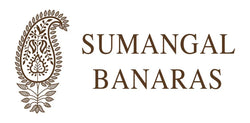The Banarasi silk saree is more than just a piece of clothing—it is a masterpiece of Indian craftsmanship, a symbol of luxury, and an heirloom passed down through generations. Every handwoven Banarasi saree for wedding or festive occasion reflects centuries-old weaving techniques, intricate patterns, and the dedication of skilled artisans.
In this blog, we take you on a fascinating journey from the weaving process to how these exquisite sarees become a treasured part of a woman's wardrobe. Whether you’re looking for the best Banarasi saree for a special occasion or simply want to understand the craftsmanship behind these sarees, this guide will give you an in-depth insight.
1. The Weaving Heritage of Banarasi Sarees
The art of weaving Banarasi silk sarees dates back to the Mughal era when Persian motifs were blended with Indian weaving styles. Varanasi (formerly Banaras) became the heart of this craftsmanship, with skilled artisans perfecting the art of silk weaving using gold and silver zari.
✔ Banarasi sarees are entirely handwoven, taking anywhere from a few weeks to several months to complete.
✔ The weaving process involves intricate designs, floral motifs, Mughal-inspired patterns, and temple borders.
✔ The most premium sarees, like the Banarasi Katan silk saree, are woven using the finest silk threads, making them a symbol of elegance and royalty.
2. The Step-by-Step Weaving Process of a Banarasi Saree
A. Selection of Silk
The process begins with choosing the best quality silk yarn. For an authentic Banarasi silk saree for wedding, pure Katan silk is often used, giving the saree a smooth and luxurious texture.
B. Designing the Saree
Before the weaving begins, intricate designs are sketched on paper. Traditional designs include:
✔ Floral jaal (net-like patterns)
✔ Paisleys and vines
✔ Peacock, elephant, and Mughal motifs
✔ Geometrical patterns in modern Banarasi sarees
C. Setting Up the Loom
Handloom weavers prepare the loom by arranging silk threads in the required pattern. It takes about 5,600 threads to create a single saree!
D. Weaving Process
Each Banarasi georgette saree or silk saree is handwoven using a traditional method called Kadwa weaving, where motifs are individually woven instead of printed or embroidered. This ensures durability and an elegant raised texture.
E. Zari Work (Gold & Silver Thread Embroidery)
The signature feature of a Banarasi saree for wedding is its intricate zari work, done with fine gold and silver threads. The more detailed the zari, the more exquisite and valuable the saree.
F. Finishing Touches
Once weaving is completed, the saree undergoes:
✔ Polishing to enhance the silk’s shine
✔ Cutting and hemming for smooth edges
✔ Final quality checks to ensure perfection
3. Types of Handwoven Banarasi Sarees
When shopping for the best Banarasi saree, it’s essential to know the different varieties available:
A. Banarasi Katan Silk Saree
✔ Woven with pure silk threads, making it one of the finest and most luxurious Banarasi sarees.
✔ Perfect for weddings, bridal trousseaus, and festive occasions.
B. Banarasi Georgette Saree
✔ Lighter in weight, making it ideal for modern styling and receptions.
✔ Features delicate zari and embroidery work.
C. Banarasi Organza Saree
✔ A sheer, glossy fabric with minimal zari, perfect for elegant and contemporary styling.
D. Banarasi Brocade Saree
✔ Features heavy zari work and embossed textures, giving it a grand and regal appeal.
4. How to Choose the Best Banarasi Saree for Your Wardrobe
A. For Brides: Banarasi Silk Saree for Wedding
-
Choose a Banarasi Katan silk saree in rich shades like red, maroon, or royal blue.
-
Pair it with Kundan or temple jewelry for a complete bridal look.
B. For Festive Occasions
-
A Banarasi georgette saree in bright colors with subtle zari work is ideal for celebrations like Diwali and Navratri.
-
Pair with silver or pearl jewelry for a trendy yet traditional touch.
C. For Formal and Office Wear
-
A lightweight Banarasi silk saree in pastel shades gives a sophisticated and graceful appearance.
-
Pair with minimalistic jewelry and a sleek bun hairstyle for a polished look.
5. Caring for Your Handwoven Banarasi Saree
To maintain the beauty of your Banarasi silk saree, follow these simple care tips:
✔ Dry Clean Only: Avoid washing in regular detergent.
✔ Store in a Muslin Cloth: This prevents moisture buildup and keeps the silk fresh.
✔ Avoid Direct Sunlight: Exposure can fade the silk and zari over time.
✔ Air It Occasionally: Prevents the fabric from getting stiff or developing an odor.
6. Where to Buy Authentic Handwoven Banarasi Sarees?
Finding an authentic Banarasi saree online can be challenging with the rise of power loom imitations. Here’s how to ensure authenticity:
✔ Look for a GI Tag (Geographical Indication) – Authentic Banarasi sarees have a GI certification proving their origin.
✔ Check the Reverse Side – Handwoven sarees have intricate threadwork at the back, unlike machine-made versions.
✔ Buy from Reputed Sellers – Always choose trusted retailers specializing in handloom sarees.
Final Thoughts: The Legacy of Handwoven Banarasi Sarees
A Banarasi silk saree is not just an outfit—it’s an emotion, a symbol of tradition, and an heirloom passed down through generations. Whether you choose a Banarasi saree for wedding, a Banarasi georgette saree for festive occasions, or a Banarasi Katan silk saree for a grand celebration, investing in an authentic handwoven saree ensures timeless elegance.


